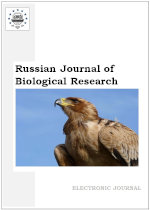Number 1. (in 1 part) September 27, 2014
Articles and Statements
1. Nikolay A. Bityukov
The Use of Bioclimatic Recourses of the Black Sea Caucuses
Russian Journal of Biological Research, 2014, Vol. (1), № 1, pp. 4-13.
Number of views: 2361 Download in PDF
2. Nikolay A. BityukovRussian Journal of Biological Research, 2014, Vol. (1), № 1, pp. 4-13.
Abstract:
This focus note features the analyses of literature materials on identification of basic regularities of time and space climate comfort distribution of the Black Sea coast of the Caucuses. According to literature data, the Southern Federal District’s territory has been divided into different bioclimatic zones.
This focus note features the analyses of literature materials on identification of basic regularities of time and space climate comfort distribution of the Black Sea coast of the Caucuses. According to literature data, the Southern Federal District’s territory has been divided into different bioclimatic zones.
Number of views: 2361 Download in PDF
Geoecological Survey of the Durmast Oak in the Black Sea Caucuses
Russian Journal of Biological Research, 2014, Vol. (1), № 1, pp. 14-30.
Number of views: 2383 Download in PDF
3. Tea T. Mchedluri, Darejan A. Margalitashvili, Tinatin G. KhokhobasviliRussian Journal of Biological Research, 2014, Vol. (1), № 1, pp. 14-30.
Abstract:
The article features a geoecological survey of the durmast oak in the Black Sea Caucuses. The method of forest vegetation monitoring was used. This method was applied at the minor pair watersheds, where one was subjected to experimental cutting and the other served as a controller. According to the materials of monitoring, the analysis on year-to-year accretion of oak wood was conducted. The dynamic of natural regeneration of the durmast oak after fires has been analyzed. Due to the forest management, the dynamic of forest litter of natural plants has been analyzed.
The article features a geoecological survey of the durmast oak in the Black Sea Caucuses. The method of forest vegetation monitoring was used. This method was applied at the minor pair watersheds, where one was subjected to experimental cutting and the other served as a controller. According to the materials of monitoring, the analysis on year-to-year accretion of oak wood was conducted. The dynamic of natural regeneration of the durmast oak after fires has been analyzed. Due to the forest management, the dynamic of forest litter of natural plants has been analyzed.
Number of views: 2383 Download in PDF
Impact of ,,Saperavi” (vitis vinifera L.) Grape Seed Oil on Physiological Processes of Rats' Organism
Russian Journal of Biological Research, 2014, Vol. (1), № 1, pp. 31-37.
Number of views: 2556 Download in PDF
4. Marzieh Negahban, Sajedeh Saeedfar, Darioush Ramezan, Moazzam Hassanpour AsilRussian Journal of Biological Research, 2014, Vol. (1), № 1, pp. 31-37.
Abstract:
As we examine biogenic amine variety of "Saperavi" grape seed oil after Cold pressing methods. They are: serotonin, adrenaline, noradrenaline, dopamine and Amino acids: aspartic acid, glutamine, asparagine, phenylalanine, tyrosine, tryptophan, threonine, leucine, methionine, pralines, and glutamine. White rats with Vistari lines were given grape seed oil during a month. It was evidence that level of their fear, stress and emotional withdrawal was decreased. Improvement of attention, memory and learning ability was visible. To feed animals with biologically active compounds, such as grape seed oil, causes quantitative distribution of biogenic amines and amino acids in the blood and that greatly improves positive effect and functional activity of living organisms. “Saperavi'' grape seed oil is characterized by unique features, so it can be used for medical purposes.
As we examine biogenic amine variety of "Saperavi" grape seed oil after Cold pressing methods. They are: serotonin, adrenaline, noradrenaline, dopamine and Amino acids: aspartic acid, glutamine, asparagine, phenylalanine, tyrosine, tryptophan, threonine, leucine, methionine, pralines, and glutamine. White rats with Vistari lines were given grape seed oil during a month. It was evidence that level of their fear, stress and emotional withdrawal was decreased. Improvement of attention, memory and learning ability was visible. To feed animals with biologically active compounds, such as grape seed oil, causes quantitative distribution of biogenic amines and amino acids in the blood and that greatly improves positive effect and functional activity of living organisms. “Saperavi'' grape seed oil is characterized by unique features, so it can be used for medical purposes.
Number of views: 2556 Download in PDF
Effects of Natural Zeolite to Reduce Salt Stress in Kentucky bluegrass (Poa pratensis)
Russian Journal of Biological Research, 2014, Vol. (1), № 1, pp. 38-45.
Number of views: 2405 Download in PDF
5. Aleksey A. Romanchuk, Alexander S. SemenovRussian Journal of Biological Research, 2014, Vol. (1), № 1, pp. 38-45.
Abstract:
Salinity is one of the most important factors limiting growth and development in cultivated species. Kentucky bluegrass was grown in boxes filled with sand (100%), 95% sand: 5% zeolite, 90% sand: 10 % zeolite and 85% sand 15% zeolite (V/V). Poa pratensis plants were irrigated with 0.24, 3.4 and 6.4 dS.m-1 salt water daily for 6 months in greenhouse condition to study the effect of different levels of zeolite on turf quality (TQ) and some physiological growth factors, salt deposition, sodium absorption ratio (SAR) and ion composition in leachate under different levels of salinity. Saline water reduced (PR), transpiration, (SC), (ME), (WUE), maximum assimilation rate (Amax), carboxylation efficiency (g, m) and net assimilation rate (A360) compared to control. Amendment of sand with zeolite increased TQ, PR, transpiration, SC, ME, WUE, (Amax), (g, m) and (A360) during both the 2nd & 3rd months at both salinity levels. Highest effect obtained in highest percent of zeolite. The beneficial effects of zeolite on turf quality and other parameters diminished 3 months after treatments. Amendment of sand with zeolite reduced leaching of Na and K but, increased leaching of Ca and Mg. Using zeolite in medium increased SAR value compared to control. Results indicate that amending with zeolite may buffer soil solution Na concentration in short-term. In the long-term, however, a substantial amount of Na may be retained concurrent with Ca & Mg exchange, thereby increasing sodicity & salinity problems.
Salinity is one of the most important factors limiting growth and development in cultivated species. Kentucky bluegrass was grown in boxes filled with sand (100%), 95% sand: 5% zeolite, 90% sand: 10 % zeolite and 85% sand 15% zeolite (V/V). Poa pratensis plants were irrigated with 0.24, 3.4 and 6.4 dS.m-1 salt water daily for 6 months in greenhouse condition to study the effect of different levels of zeolite on turf quality (TQ) and some physiological growth factors, salt deposition, sodium absorption ratio (SAR) and ion composition in leachate under different levels of salinity. Saline water reduced (PR), transpiration, (SC), (ME), (WUE), maximum assimilation rate (Amax), carboxylation efficiency (g, m) and net assimilation rate (A360) compared to control. Amendment of sand with zeolite increased TQ, PR, transpiration, SC, ME, WUE, (Amax), (g, m) and (A360) during both the 2nd & 3rd months at both salinity levels. Highest effect obtained in highest percent of zeolite. The beneficial effects of zeolite on turf quality and other parameters diminished 3 months after treatments. Amendment of sand with zeolite reduced leaching of Na and K but, increased leaching of Ca and Mg. Using zeolite in medium increased SAR value compared to control. Results indicate that amending with zeolite may buffer soil solution Na concentration in short-term. In the long-term, however, a substantial amount of Na may be retained concurrent with Ca & Mg exchange, thereby increasing sodicity & salinity problems.
Number of views: 2405 Download in PDF
R and Q haplogroups of Y-chromosome and Proto-North Caucasian Substratum of Proto-Indo-Europeans
Russian Journal of Biological Research, 2014, Vol. (1), № 1, pp. 46-68.
Number of views: 2263 Download in PDF
6. Guzaliya Z. SamigullinaRussian Journal of Biological Research, 2014, Vol. (1), № 1, pp. 46-68.
Abstract:
More than seven years ago A.A. Romanchuk (2008; 2009; 2009a), basing on the analysis of archaeological and linguistic data, suggested the localization of the Dene-Sino-Caucasian Motherland in the Eastern Eurasia. The ―East-Eurasian hypothesis‖ of Dene-Sino-Caucasian Motherland found new confirmations from the analysis of physical anthropogy’s data: odontology (Romanchuk 2012) and craniology (Romanchuk 2013). To continue the verification of ―East-Eurasian hypothesis‖, this paper considers the spatial distribution of some (East-Eurasian by origin) haplogroups of Y-chromosome – R and Q (as well as some others –haplogroup L, first of all). The analysis has demonstrated strong correlation between R and Q haplogroups and Dene-Sino-Caucasian peoples: Sino-Tibetan, Na-Dene, North Caucasian, Burushasky, and Basque. Evidently, the spread of R (and Q) haplogroups from Central Asia into the Western Asia, which occurred in the final of Late Pleistocene – Early Holocene was closely related with Sino-Caucasian peoples. Some of these Sino-Caucasian peoples, probably closely related to Proto-North Caucasians, became for Proto-Indo-Europeans the source of R haplogroup. Thus, to sum up: we think that the analysis of R and Q haplogroups’ spatial distribution proves the ―East-Eurasian hypothesis‖ of the Dene-Sino-Caucasian Motherland. Although, we suppose that the main goal of this paper, as well as of those all previous, is to stimulate the broad interdisciplinary discussion of the issue.
More than seven years ago A.A. Romanchuk (2008; 2009; 2009a), basing on the analysis of archaeological and linguistic data, suggested the localization of the Dene-Sino-Caucasian Motherland in the Eastern Eurasia. The ―East-Eurasian hypothesis‖ of Dene-Sino-Caucasian Motherland found new confirmations from the analysis of physical anthropogy’s data: odontology (Romanchuk 2012) and craniology (Romanchuk 2013). To continue the verification of ―East-Eurasian hypothesis‖, this paper considers the spatial distribution of some (East-Eurasian by origin) haplogroups of Y-chromosome – R and Q (as well as some others –haplogroup L, first of all). The analysis has demonstrated strong correlation between R and Q haplogroups and Dene-Sino-Caucasian peoples: Sino-Tibetan, Na-Dene, North Caucasian, Burushasky, and Basque. Evidently, the spread of R (and Q) haplogroups from Central Asia into the Western Asia, which occurred in the final of Late Pleistocene – Early Holocene was closely related with Sino-Caucasian peoples. Some of these Sino-Caucasian peoples, probably closely related to Proto-North Caucasians, became for Proto-Indo-Europeans the source of R haplogroup. Thus, to sum up: we think that the analysis of R and Q haplogroups’ spatial distribution proves the ―East-Eurasian hypothesis‖ of the Dene-Sino-Caucasian Motherland. Although, we suppose that the main goal of this paper, as well as of those all previous, is to stimulate the broad interdisciplinary discussion of the issue.
Number of views: 2263 Download in PDF
Secure Methods of Assessing Toxicity of Waste in Food Industry of the Udmurt Republic
Russian Journal of Biological Research, 2014, Vol. (1), № 1, pp. 69-72.
Number of views: 2310 Download in PDF
7. Russian Journal of Biological Research, 2014, Vol. (1), № 1, pp. 69-72.
Abstract:
The article analyzes environmentally sound technologies for assessment of waste toxicity in dairy industry. The efficiency of the biotesting as a method of assessing the quality of wastewater treatment. Case study: JSC "Glazov-moloko" Kipryatsky Milk Reception Station. The authors suggested a technological solution for wastewater treatment at the Kipryatinsky Milk Reception Station.
The article analyzes environmentally sound technologies for assessment of waste toxicity in dairy industry. The efficiency of the biotesting as a method of assessing the quality of wastewater treatment. Case study: JSC "Glazov-moloko" Kipryatsky Milk Reception Station. The authors suggested a technological solution for wastewater treatment at the Kipryatinsky Milk Reception Station.
Number of views: 2310 Download in PDF








